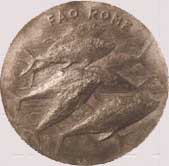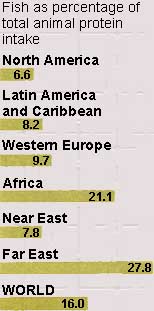
| Fisheries at the limit? |
| PREVIOUS FILE |
 |
Compared with other agricultural commodities, fish plays an important role as an earner of foreign exchange: net exports of fishery products by developing countries were more than US$ 11 000 million in 1993, much higher than coffee, bananas, rubber, tea, meat, rice or other typical commodities. |
Fishing is an important source of highly nutritious food, income and employment. Millions of people in Asia get most of their dietary protein from the aquatic harvest. In all, marine and inland fisheries provide nearly 30 percent of the region's animal protein; in Africa the proportion is 21 percent; in Latin America, 8 percent. About 30 percent of world production is turned into fishmeal to fatten livestock or farmed fish rather than eaten directly by humans.
About 60 percent of the world fish harvest is caught by developing countries where 100 million people depend on fishing and related industries for their livelihoods. By far the majority of world fish taken, some 85 percent, comes from the oceans. Although fish farming is gaining ground, fishing is still the main expression of man's ancient role as a hunter-gatherer.
Since 1950 the world fish catch, excluding aquaculture, has increased fivefold - rising from 20 million tonnes to peak at slightly less than 90 million tonnes in 1989. This period of expansion was made possible in large part by the introduction of new technologies and the spread of fishing fleets from traditional fishing areas to new ones, many of them in the southern hemisphere. No major commercial fish stock remains untouched. By the beginning of the 1990s, about 69 percent of the stocks for which data were available to FAO were either fully to heavily exploited (44 percent), overexploited (16 percent), depleted (6 percent) or very slowly recovering from overfishing (3 percent). As a result, the world catch has fallen in recent years although it now seems to be levelling off at around 85 million tonnes per year.
The world's fishing fleet has grown twice as fast as catches and there are now about 3.5 million vessels worldwide. Asia has the largest fleet with 42 percent of the total registered tonnage, followed by the republics of the former USSR with 30 percent. Africa has the smallest one at 2.7 percent. Government subsidies have helped keep most big fishing fleets afloat: in 1989 the world's 20 largest fishing nations paid out US$ 54 000 million in subsidies to catch US$ 70 000 million worth of fish. Such overcapacity has led to chronic overfishing with too many boats chasing too few fish.
Fish production and utilization
World fish production* (Thousand tonnes)

*Including aquaculture production, excluding aquatic plant
World fish utilization (Thousand tonnes)

Contribution of fish to human diet, 1987-89

Nearly 70 percent of the world's marine fish stocks are in trouble and urgently in need of conservation. Catches have collapsed in the Black Sea; less than 200 000 tonnes of fish were landed in 1991, compared to 1 million tonnes in the late 1980s. Stocks of bottom-living fish in the East China and Yellow Seas have fallen to between one-fifth and one-tenth of their highest levels. Other crisis areas include the Northwest and Northeast Atlantic, the North Sea, the Mediterranean and Black Seas, the Central Baltic, the Gulf of Thailand and the Western Central Pacific. Nearly all the inland fisheries of Asia and Africa also show signs of overexploitation.
Attempts to manage marine fisheries have generally failed. Instead conflicts have grown as stocks have fallen. Developed country fleets have clashed over fisheries in both the Northwest and Northeast Atlantic while large-scale commercial fleets are at odds with small-scale artisanal fishermen off many developing countries.
The international fishery commissions, established under the auspices of FAO (the first in 1948), have broadened the scope of management options and included many developing countries, but have so far had little success other than trying to impose quotas and regulate fishing gear and boat size. But they provide the mechanisms for sustainable fisheries management if countries would show the necessary cooperation and political will.
The third UN Convention on the Law of the Sea, which came into force in 1994, enables coastal states to establish exclusive economic zones, usually stretching 200 miles from their shores, where they have complete control of resources - providing a new opportunity for better regulation. In 1994 work started on drafting a Code of Conduct for Responsible Fisheries under the auspices of FAO, offering hope - if it is observed - of a new era in fisheries management.
World fish catches, 1993
Click here to see the map![]()

Area numbers 01-07 refer to inland fisheries. All
other area numbers refer to marine fisheries. Countries which
caught over 200 000 tonnes within each marine FAO area are listed
and those which caught over 1 million tonnes are shown in
capitals.
International
fishery commissions
(*FAO fishery body)
Pacific Ocean
North Pacific Marine Science Organization (PICES)
International North Pacific Fisheries Commission (INPFC)
Inter-American Tropical Tuna Commission (IATTC)
Council of the Eastern Pacific Tuna Fishing Agreement (CEPTFA)
Eastern Pacific Tuna Fishing Organization (OAPA)
South Pacific Permanent Commission (CPPS)
South Pacific Forum Fisheries Agency (FFA)
South Pacific Commission (SPC)
Atlantic Ocean and adjacent seas
International Council for the Exploration of the Sea (ICES)
North-East Atlantic Fisheries Commission (NEAFC)
North Atlantic Salmon Commission (NASCO)
Northwest Atlantic Fisheries Organization (NAFO)
General Fisheries Council for the Mediterranean (GFCM) *
Fishery Committee for the Eastern Central Atlantic (CECAF) *
Western Central Atlantic Fishery Commission (WECAFC) *
Regional Fisheries Advisory Commission for the Southwest Atlantic
(CARPAS)
International Commission for the Conservation of Atlantic Tunas
(ICCAT)
International Commission for the Southeast Atlantic Fisheries
(ICSEAF)
Indian Ocean and Indo-Pacific area
Indian Ocean Tuna Commission (IOTC) *
Indian Ocean Fishery Commission (IOFC) *
Indo-Pacific Fishery Commission (IPFC) *
Other areas
International Whaling Commission (IWC)
Latin American Organization for the Development of Fisheries
(OLDEPESCA)
Commission for the Conservation of Antarctic Marine Living
Resources (CCAMLR)
Commission for Inland Fisheries of Latin America (COPESCAL) *
European Inland Fisheries Advisory Commission (EIFAC) *
Committee for Inland Fisheries of Africa (CIFA) *
Advisory Committee on Fisheries Research (ACFR)
Top ten
fishing nations, 1993 |
Top ten marine
catches, 1993 |
Total world
catch, 1993 |
| PREVIOUS FILE |